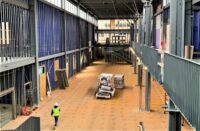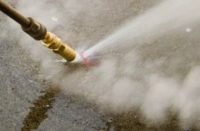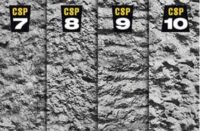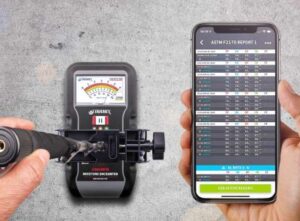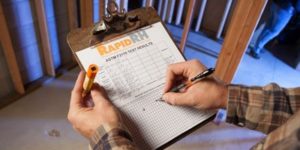
When you’re relaxing with a woodworking project in your garage, an important adage is “Measure twice, cut once.”
When you’re called in to decorate a concrete floor, measuring twice isn’t necessary, but do measure the moisture in that slab before proceeding.
Sure, you can eyeball it, but a wrong guess on how much moisture is in the concrete may mean even the best product can flake, chip or delaminate — leaving you with an unsightly mess and an unhappy client.
Got moisture?
Walking up to a job site, just about any experienced contractor is going to have an inkling of at least the potential for moisture issues. It is visually possible to tell when a problem is present.
Larry Bucher, national manager of architectural products/terrazzo for Key Resin Co. based in Batavia, Ohio, says an experienced contactor will notice shades or shadowing in the concrete, and look at how and where the job sits.
“Most slabs will exhibit obvious moisture issues or tendencies,” he says. “A seasoned contractor will look at the color of the concrete, check for dark marks in it and look at the site.”
“Yeah, I can probably tell 90 percent of the time after years of just looking at it,” says Carl Schlosser of AAF Flooring in Stony Brook, New York. “You can see how dense it is or how soft. And, if it’s above grade, typically you have a good chance of no moisture, but that isn’t necessarily true if it’s on grade or below.”
However, Rob Schumacher of Phoenix Commercial Flooring in Hicksville, New York, says there are other things he looks for, as well.
“A vapor barrier is important, but other factors include whether it’s close to the water, say an area with a high water table, or improper drainage
around the building,” Schumacher says. “Sometimes the drainage will be toward the building rather than away from it.”
That’s not to say a project that’s above grade is going to be safe from moisture issues, though. Both Schumacher and Schlosser cite the use of concrete that may not be quite up to the job.
“The masons who are doing the concrete might not have used the right mix,” says Schlosser. “It might have too much water in it to begin with or not enough sand. Often, the problem is because the mason contractor has dropped the ball.”
For that reason alone, it’s not possible to limit problems with moisture to certain geographical areas of the country. Jeff Bonkiewicz, channel manager with Laticrete North America based in Bethany, Connecticut, says while that company sees high demand for its moisture mitigation products from the South and Southeast, there’s also a lot of call for its products from the Midwest and Southern California.
“In really arid areas, such as Phoenix, you usually have less moisture issues,” Bonkiewicz says. “That’s due to its arid geography and topography, but that doesn’t mean you don’t have any.”

To test or not to test
In a perfect world, there is one situation where migrating moisture isn’t a problem. That’s if the concrete has been mixed correctly and there’s a proper vapor barrier under the slab.
Glenn Tench, director of marketing for Hampshire, Illinois-based W.R. Meadows Inc. — a company that manufactures vapor barriers — says if you know one is present you can breathe a little easier.
“With a properly installed vapor barrier, one that meets ASTM (International) E1745, you aren’t going to have the issues with moisture migration post-construction,” he says. The only things you’d be dealing with is the concrete’s age and if enough moisture has migrated out so you can install the flooring.
The other exception: if the job is outdoors. Bonkiewicz estimates 99 percent of Laticrete’s moisture mitigation products are used indoors, and Key Resin’s Bucher says most exterior jobs use “breathable” toppings that allow the moisture to go through.
If you can’t give a positive answer to the vapor barrier — and, with older concrete, you may not be able to find out the answer — your only other option is to test to see if moisture is present.
Testing is an approach recommended by both product manufacturers and contractors alike.
“We always recommend a moisture test first,” says Bonkiewicz.
“We recommend testing 100 percent,” says Bucher. “It’s a bad risk not to test all slabs prior to applying any floor covering or finish.”
“We always test, absolutely,” says Schumacher. “It’s much more reliable than going by visual appearance.”
“It only takes a couple of minutes to drop a can in it and read it,” says Schlosser. “It’s not a big deal to test it.”
Schlosser’s “couple of minutes” is a bit more complicated than that, of course. However, the preferred method for testing the moisture in a concrete slab isn’t all that complex and has recently become less time-intensive, as well.
“I like the Rapid RH system,” he says. “You just drill a hole in the concrete, the sensor goes in and you have an electronic meter that goes into the sensor that will give you temperature and relative humidity pretty well instantly.”
That product’s manufacturer, Wagner Meters of Rogue River, Oregon, requires the sensors be left in the concrete for 24 hours — down from 72 hours — in a frequency established by ASTM.
And, product manufacturers don’t necessarily favor the RH (relative humidity) test over its main competitor, which measures the weight of calcium chloride packets left sitting on the concrete for 72 hours.
“We don’t have an official testing procedure we recommend,” says Laticrete’s Bonkiewicz. “We leave that up to the concrete and coatings pros who work in the field every day.”
A big question must be how the property owner, building manager, general contractor or whomever is overseeing the job feels about taking the time to test. Schumacher says it hasn’t been a problem in his experience.
“They understand,” he says. “They want the job done right, they want it to last and they’re paying good money for the installation, so they certainly understand.”
Doing it right
If the moisture level is greater than 80 percent, it’s time to go with a moisture-mitigation product. Finding the right product is as simple as finding one that meets or exceeds the ASTM F3010 standard, which will then essentially become a vapor barrier on top of the concrete, says Meadows’ Tench.
“It will act as a priming agent for concrete between your epoxy or polyaspartic coating that you’re going to put on top of the primer,” says Laticrete’s Bonkiewicz. “That will provide an extra insurance policy against delamination and moisture.”
Depending on the product, it may also accept pigments and even allow the broadcasting of chip or quartz media. And when installed properly, it likely comes with a warranty.
The availability of that warranty boosts a client’s confidence, but it also requires installers to pay close attention to the product’s installation. As Bonkiewicz notes, bad prep will void the warranty.
“For the record, that’s our No. 1 issue in the field,” he says. “We stress to our customers, never skimp on the surface prep. Take it seriously because the entire job is riding on it.”
Because Laticrete recommends a concrete surface profile of anywhere from three to five for its moisture mitigation product, shot-blasting is the suggested method for surface prep.
The contractors agree, although Schlosser says he will sometimes profile with a grinding machine.
“Prep is often a step people overlook,” he says. “They cut corners, or they don’t profile, and that’s where it goes bad. Get your test readings and do the prep.”
Key Resin’s Bucher even recommends doing another moisture test once the floor is opened up.
“Once you blast a floor, you’re going to start drying it up,” he says. “If you test an unblasted floor, it will read differently. Ideally, you should blast the floor and then do the readings, but people don’t want to take the time.”
Once your surface is prepped, good application is also key. It’s critical to get enough product down, says Bucher.
“Pay attention to the mixing instructions on the data sheets and don’t cut corners on surface prep,” says Bonkiewicz.
Bucher compares doing the moisture testing to carrying car insurance, and Schlosser says he’s turned down jobs where the people contracting the job weren’t willing to take the time to have it done.
“What if the client has moved in all their furniture and desks and glass walls and there’s a problem,” he postulates. “Are you going to try to fix a concrete slab with everybody on it?”
www.keyresin.com
www.laticrete.com
www.pnxfloors.com
www.wrmeadows.com
